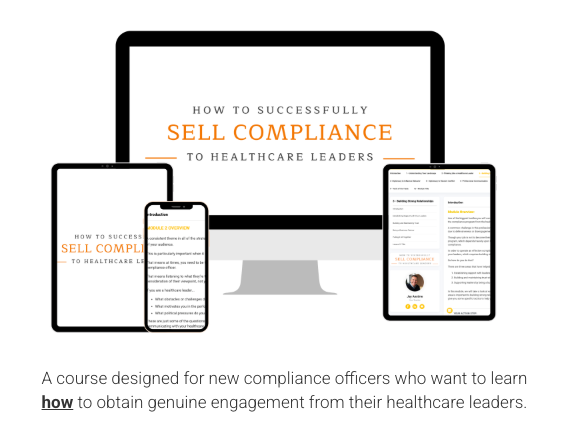For early-career compliance officers, one of the biggest challenges isn’t understanding the regulations—it’s learning how to frame compliance in a way that healthcare leaders actually want to support.
Too often, compliance is seen as the department of “no”—ya know, that mythical place where good ideas go to get shut down. The truth is, compliance can be a strategic partner that helps the organization achieve its goals sustainably—and compliantly. The difference between those two perceptions though depends on how you communicate your compliance message.
Framing is the art of positioning a communication so that others understand how it helps them succeed. When done well, it shifts perceptions, builds trust, and opens doors that otherwise stay closed.
In this article, I’ll cover how to use framing in order to position your next compliance initiative as a solution, and not a barrier.
Start With Their Goals—Not Yours
Before you talk about compliance requirements, talk about what matters to your audience. In my experience, healthcare leaders make decisions based on three things: risk, relationships, and results. More specifically they’re focused on things like: patient outcomes, business strategy, financial performance, and staff efficiency.
If you start your message with “The regulation says…” you’ve already lost them.
Instead, begin with their priorities. For example, you might try something like:
“I know you’re trying to reduce denials and document efficiently. As it relates to (insert the departmental process at issue), here’s a way I can help you with that.”
When you frame compliance within the context of their goals, it demonstrates alignment to them, rather than opposition. From the perspective of your audience, it makes your message more relevant and less adversarial.
Recast Compliance as a Strategic Business Advantage
If you follow Ross Ronan of Ronan Healthcare Consultants, then you know, he is a huge proponent of framing compliance to healthcare executives as a strategic business advantage.
And Ross is right.
Every organization has strategic objectives — growth, reputation, quality, and innovation to name a few. What often gets overlooked by leaders is that compliance supports all of these objectives—that is, when positioned correctly. For example, when your organization is in the business of patient care, trust is a market advantage. Relatedly, an organization with a strong culture of compliance signals to patients that the organization is a safe and ethical organization to do business with.
Since that example is a little high-level, let me give you another one closer to your work. Let’s assume you’re in a meeting to discuss the launch of a new service line. In that scenario, framing compliance as a market advantage might look like saying:
“I can help set guardrails to ensure (insert the new service line) is built on a solid foundation that can withstand regulatory scrutiny from an auditor or investigator.”
When you reposition compliance from looking like check-the-box to a strategic business advantage, you shift their mindset from being viewed as a regulatory burden to an enabler of organizational success.
Use Language That Invites Collaboration
Let’s face it, words matter.
When I was in law school, I had a professor who use to tell us, “Students, your craft will be defined by two things: your time and your words. Choose them both wisely”. While our profession is not the practice of law, I think the message equally applies to our work.
Compliance-ey phrases like “we can’t do that” or “that’s not compliant” shuts down dialogue—and like—real fast. Instead, you want to use language that invites collaboration, such as:
“Here’s how we can do that within the rules.”
“Let’s look for an option that meets both our operational and compliance needs.”
“We can accomplish the goal — we just need to make sure the process is structured the right way.”
This subtle linguistic shift keeps you positioned as a problem solver, not an obstacle. Over time, it also builds your credibility and respect as someone who understands the realities of the organization’s business.
Tell the Story Behind the Rule
Whether it’s delivering education, investigating an issue, or conducting an audit, everything you work on has context around it.
Everything.
Sometimes referred to as, “the why”, providing context helps your leaders understand the reasoning behind your message that compliance matters. For a compare and contrast, consider the following example:
Framing compliance through context appeals more directly to your leaders’ sense of responsibility and aligns with the organization’s mission and values.
Framing and The Politics of Healthcare
In the political landscape of healthcare, perception often shapes influence. Even if your compliance recommendations are technically correct, how you frame them determines whether leaders view you as a partner or a problem.
By framing compliance as a solution, you achieve three goals towards effectively navigating the politics of healthcare:
Strengthening alliances with your operational and clinical leaders.
Reducing resistance and defensiveness towards the compliance program.
Positioning yourself as a trusted advisor who understands the business.
When your healthcare leaders see compliance as something that helps them achieve their goals, you gain access, trust, and best of all—a seat at their decision-making table.
Pulling it All Together
In a world where corporate politics and competing priorities are constant, how you frame compliance determines whether your message lands — or gets lost. Simply put, knowing the regulations makes you competent, knowing how to influence makes you effective.
Framing isn’t just for big presentations — it’s a mindset. You can apply it in every meeting, email, and conversation.
Compliance officers who master the art of framing don’t just get better results — they change the culture of compliance in their organizations. They move from being seen as enforcers to being recognized as leaders who drive integrity, collaboration, and strategic success.
So the next time you share a compliance recommendation, ask yourself—“Am I presenting this as a roadblock, or as a path forward?”
Myth: Healthcare leaders don’t care about compliance.
Truth: They do care—but they need you to frame it in a way that connects to their priorities.
How do you do that?
I’ll show you how in—𝐇𝐨𝐰 𝐭𝐨 𝐒𝐮𝐜𝐜𝐞𝐬𝐬𝐟𝐮𝐥𝐥𝐲 𝐒𝐞𝐥𝐥 𝐂𝐨𝐦𝐩𝐥𝐢𝐚𝐧𝐜𝐞 𝐭𝐨 𝐇𝐞𝐚𝐥𝐭𝐡𝐜𝐚𝐫𝐞 𝐋𝐞𝐚𝐝𝐞𝐫𝐬.
𝐘𝐨𝐮𝐫 𝐫𝐞𝐠𝐢𝐬𝐭𝐫𝐚𝐭𝐢𝐨𝐧 𝐢𝐧𝐜𝐥𝐮𝐝𝐞𝐬:
The complete interpersonal communication framework & tools
Lifetime access to the course materials
Personalized instructor support
Access to an exclusive student community
Self-study CEU credits available




